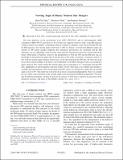Viewing Angle of Binary Neutron Star Mergers
Author(s)
Chen, Hsin-Yu; Vitale, Salvatore; Narayan, Ramesh
DownloadPublished version (844.4Kb)
Publisher with Creative Commons License
Publisher with Creative Commons License
Creative Commons Attribution
Terms of use
Metadata
Show full item recordAbstract
© 2019 authors. Published by the American Physical Society. The joint detection of the gravitational wave (GW) GW170817 and its electromagnetic (EM) counterparts GRB170817A and kilonova AT 2017gfo has triggered extensive study of the EM emission of binary neutron star mergers. A parameter which is common to and plays a key role in both the GW and the EM analyses is the viewing angle of the binary's orbit. If a binary is viewed from different angles, the amount of GW energy changes (implying that orientation and distance are correlated) and the EM signatures can vary, depending on the structure of the emission. Information about the viewing angle of the binary orbital plane is therefore crucial to the interpretation of both the GW and the EM data and can potentially be extracted from either side. In the first part of this study, we present a systematic analysis of how well the viewing angle of binary neutron stars can be measured from the GW data. We show that if the sky position and the redshift of the binary can be identified via the EM counterpart and an associated host galaxy, then for 50% of the systems the viewing angle can be constrained to ≤7° uncertainty from the GW data, independent of electromagnetic emission models. On the other hand, if no redshift measurement is available, the measurement of the viewing angle with GWs alone is not informative, unless the true viewing angle is close to 90°. This holds true even if the sky position is measured independently. Then, we consider the case where some constraints on the viewing angle can be placed from the EM data themselves. We show that the EM measurements can then be used in the analysis of GW data to improve the precision of the luminosity distance, and hence of the Hubble constant, by a factor of 2-3.
Date issued
2019Department
Massachusetts Institute of Technology. Department of Physics; MIT Kavli Institute for Astrophysics and Space Research; Massachusetts Institute of Technology. Department of PhysicsJournal
Physical Review X
Publisher
American Physical Society (APS)